My interest in plants began early. Although my mother reports that, as a baby, I would cry when placed barefoot in the grass, I think this was more about my disdain for monocultures than an aversion to plants. All kidding aside, I spent a lot of my childhood outdoors with my photosynthetic friends. Around the age of 9 or 10, I would often lay in the grass, sketching the flowers in my yard under the shade of a giant bur oak tree. Daffodils were a favorite subject, as were the grape hyacinths. At the time I did not know which plants were introduced, which were native, or what was invasive - it was all just nature to me. I would regularly explore the forests along the Alum Creek floodplain near our home, and generally felt most comfortable in these natural settings surrounded by plants. I still feel this way - and I relish opportunities (like the writing of this article) to share my love of plants.
During college, I took an aquatic botany course taught by Dr. Ron Stuckey, which got me keenly interested in wetlands and wetland vegetation (this training has served me well in my wetland-focused career, culminating in my position as Chief Scientist and co-owner [with my CEO/MBA wife, Chris] of the ecological and wetland consulting firm MAD Scientist Associates in Westerville). I also volunteered to serve as a tour guide at the State Fair, where Division of Natural Areas and Preserves botanist Allison Cusick taught me the plants of the prairie in a very entertaining training session. After completing my undergraduate degree, my appetite for plant knowledge continued to grow (pun intended!). I took continuing education courses at Otterbein University that covered local flora and dendrology (taught by exceptional Metro Parks of Columbus and Franklin County naturalist Jim Stahl). These classes got me hooked and more invested than ever.
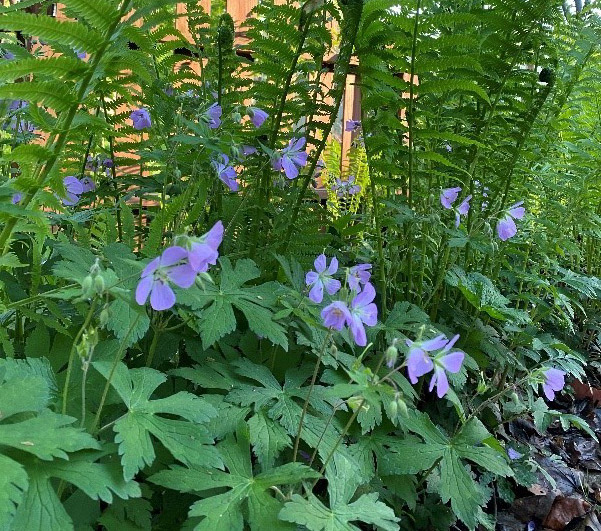 When a friend told me that there was a woodlot full of native wildflowers just up the street from his home that was to be cleared for new development, we sprang into action with a plant rescue operation. We dug out chunks of rich woodland soil, filled with wild geranium (Geranium maculatum), trout lilies (Erythronium albidum, E. americanum), wild ginger (Asarum canadense), Virginia waterleaf (Hydrophyllum virginianum), and Virginia bluebells (Mertensia virginica), and loaded our adopted plants into cardboard box lids for transport. As we were loading the car, we noticed someone sitting across the street watching. He asked, “What are you doing?” We explained that we were going to relocate the plants, because we heard that there were plans to develop the lot - to which the man replied “I know. That’s my lot!” We froze for a second, feeling like two bandits caught red-handed with our greenery. Thankfully, he was fine with (and even encouraged) our salvage effort, noting that he would be building his house and seeding a lawn in this area. He was happy to see the plants go to a loving home, our home. And so began our family’s first step toward growing native.
When a friend told me that there was a woodlot full of native wildflowers just up the street from his home that was to be cleared for new development, we sprang into action with a plant rescue operation. We dug out chunks of rich woodland soil, filled with wild geranium (Geranium maculatum), trout lilies (Erythronium albidum, E. americanum), wild ginger (Asarum canadense), Virginia waterleaf (Hydrophyllum virginianum), and Virginia bluebells (Mertensia virginica), and loaded our adopted plants into cardboard box lids for transport. As we were loading the car, we noticed someone sitting across the street watching. He asked, “What are you doing?” We explained that we were going to relocate the plants, because we heard that there were plans to develop the lot - to which the man replied “I know. That’s my lot!” We froze for a second, feeling like two bandits caught red-handed with our greenery. Thankfully, he was fine with (and even encouraged) our salvage effort, noting that he would be building his house and seeding a lawn in this area. He was happy to see the plants go to a loving home, our home. And so began our family’s first step toward growing native.
Several years passed, and when the buyers of our first home indicated that they were not interested in maintaining our native wildflower bed, these “rescue plants” were moved yet again! Many of those plants, particularly the wild geranium, have flourished around our patio and continue to provide us with spectacular seasonal color. We value the sense of connectedness these plants provide to the natural cycles that are occurring throughout the year: when our wild geraniums and bluebells are in bloom, we know that these and other spring ephemerals are taking advantage of the sunlight penetration to the forest floor and putting on a show to attract spring pollinators in the fully natural plant communities in our region.
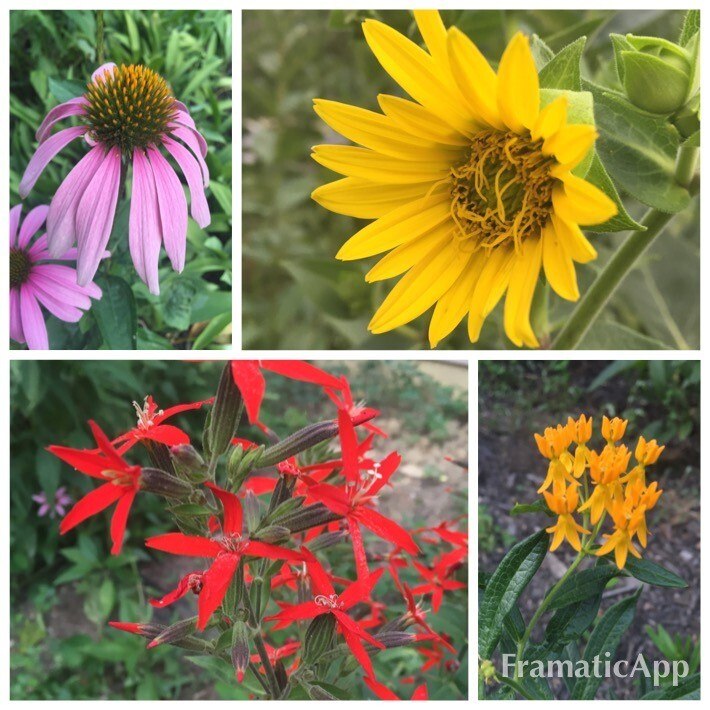 Having become familiar with and enamored of prairie plants through my State Fair experience, we decided to plant an entire bed along one side of the house with rosinweed (Silphium integrifolium), tall coreopsis (C. tripteris), spotted joe-pye weed (Eutrochium maculatum), false oxeye (Heliopsis helianthoides), purple coneflower (Echinacea purpurea), wild bergamot (Monarda fistulosa), butterfly weed (Asclepias tuberosa), and royal catchfly (Silene regia). We call this now densely-vegetated bed our “Little Prairie on the House TM.” As we got increasingly settled into our new location in Westerville (with a fairly large lot of nearly 0.4 acres), we started looking for new projects - ways to enhance the ecological value and aesthetics of our property.
Having become familiar with and enamored of prairie plants through my State Fair experience, we decided to plant an entire bed along one side of the house with rosinweed (Silphium integrifolium), tall coreopsis (C. tripteris), spotted joe-pye weed (Eutrochium maculatum), false oxeye (Heliopsis helianthoides), purple coneflower (Echinacea purpurea), wild bergamot (Monarda fistulosa), butterfly weed (Asclepias tuberosa), and royal catchfly (Silene regia). We call this now densely-vegetated bed our “Little Prairie on the House TM.” As we got increasingly settled into our new location in Westerville (with a fairly large lot of nearly 0.4 acres), we started looking for new projects - ways to enhance the ecological value and aesthetics of our property.
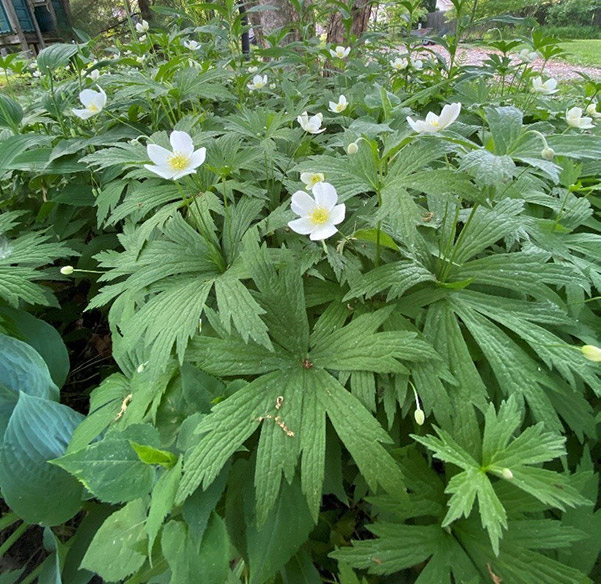 Our next project addressed a wetness problem in the back part of our lot that we noticed would hold water after every storm. Being a wetland scientist, it seemed logical to work with the hydrology and establish a wetland garden in this location. I dug a slightly deeper depression in which we planted pussy willow (Salix discolor), soft rush (Juncus effusus), swamp rose mallow (Hibiscus moscheutos), obedient plant (Physostegia virginiana), and other wetland species. I was amused when, after the next rain, I looked out our back window while pouring my morning coffee and witnessed two mallard ducks, a male and a female, drop down between our neighborhood houses and land directly on this hundred square foot puddle in our yard! They no longer visit because, although it still fills with water, the entire depression is now filled with vegetation. We recently expanded this “lowered bed” garden, and have added cardinal flower (Lobelia cardinalis), swamp milkweed (Asclepias incarnata, a monarch favorite!), Muskingum sedge (Carex muskingumensis), buttonbush (Cephalanthus occidentalis), queen of the prairie (Filipendula rubra), flat-topped aster (Doellingeria umbellata), and royal fern (Osmunda regalis).
Our next project addressed a wetness problem in the back part of our lot that we noticed would hold water after every storm. Being a wetland scientist, it seemed logical to work with the hydrology and establish a wetland garden in this location. I dug a slightly deeper depression in which we planted pussy willow (Salix discolor), soft rush (Juncus effusus), swamp rose mallow (Hibiscus moscheutos), obedient plant (Physostegia virginiana), and other wetland species. I was amused when, after the next rain, I looked out our back window while pouring my morning coffee and witnessed two mallard ducks, a male and a female, drop down between our neighborhood houses and land directly on this hundred square foot puddle in our yard! They no longer visit because, although it still fills with water, the entire depression is now filled with vegetation. We recently expanded this “lowered bed” garden, and have added cardinal flower (Lobelia cardinalis), swamp milkweed (Asclepias incarnata, a monarch favorite!), Muskingum sedge (Carex muskingumensis), buttonbush (Cephalanthus occidentalis), queen of the prairie (Filipendula rubra), flat-topped aster (Doellingeria umbellata), and royal fern (Osmunda regalis).
As we have learned more about introduced and invasive plants and the damage they cause, we have become increasingly dedicated to systematically eradicating introduced species around our property and replacing them with more ecologically valuable and appropriate native species. Our burning bush (Euonymus alatus) shrubs have been replaced with common nine bark (Physocarpus opulifolius) and arrowwood viburnum (V. dentatum). I took out an overgrown forsythia bush and planted wild hydrangea (H. arborescens) in its place. Fragrant sumac (Rhus aromatica) has been substituted for Japanese barberry (Berberis thunbergii) and boxwood (Buxus spp.). A swamp white oak (Quercus bicolor) grows in the front yard, replacing a flowering crabapple – but at a more suitable and safe distance from the house. We plan to soon replace our Chinese silver grass (Miscanthus sinensis) with switch grass (Panicum virgatum) or sea oats (Chasmanthium latifolium) - it’s a process!
Our latest efforts in this journey to a natives-dominated landscape have been catalyzed by two key circumstances: 1) Becoming part owners of a (predominantly) native plant nursery, Scioto Gardens, in Delaware, Ohio; and 2) Participation in the Westerflora residential garden tour in July, which led to an adrenaline-fueled frenzy of landscape improvements, planting bed expansion, and LOADS of new native plants from Scioto Gardens.
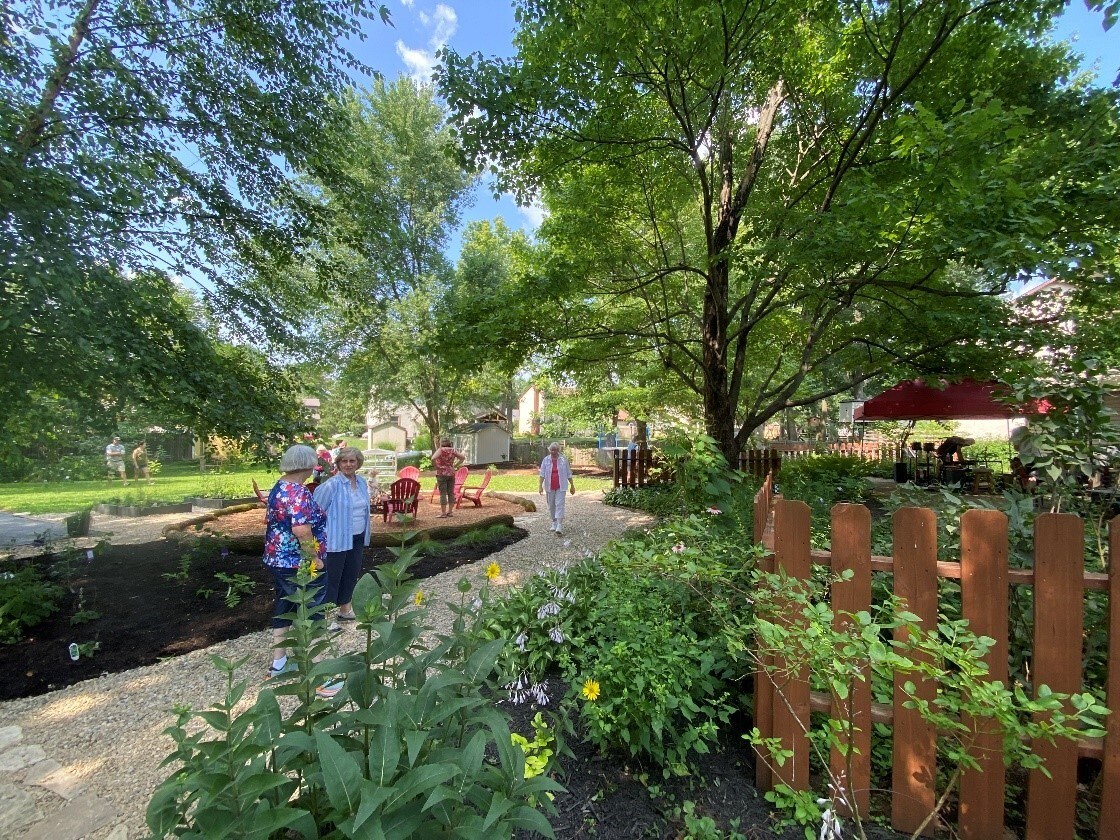
Our preparations for Westerflora resulted in the addition of over 30 new species to our yard, including hoptree (Ptelea trifoliata), winged sumac (Rhus copallinum), black and red chokeberry (Aronia melanocarpa; A. arbutifolia), spicebush (Lindera benzoin), Virginia sweetspire (Itea virginica), yarrow (Achillea millefolium), turtlehead (Chelone glabra), maidenhair fern (Adiantum pedatum), interrupted fern (Osmunda claytoniana), shrubby St. John’s wort (Hypericum prolificum), Carolina wild petunia (Ruellia carolinensis), lyre-leaved sage (Salvia lyrata), downy skullcap (Scutellaria incana), blue-stemmed goldenrod (Solidago caesia), anise hyssop (Agastache foeniculum), Virginia wild strawberry (Fragaria virginiana), tall larkspur (Delphinium exutatum), foam flower (Tiarella cordifolia), pearly everlasting (Anaphalis margaritacea), orange coneflower (Rudbeckia fulgida), gray beardtongue (Penstemon canescens), purple-headed sneezeweed (Helenium flexuosum), hoary mountain mint (Pycnanthemum incanum), Appalachian sedge (Carex appalachica), scarlet beebalm (Monarda didyma), dense blazing star (Liatris spicata), whorled milkweed (Asclepias verticillata), wild quinine (Parthenium integrifolium), flowering raspberry (Rubus odoratus; can’t wait to see/smell these plants bloom!), mistflower (Conoclinium coelestinum), and wild stonecrop (Sedum ternatum).
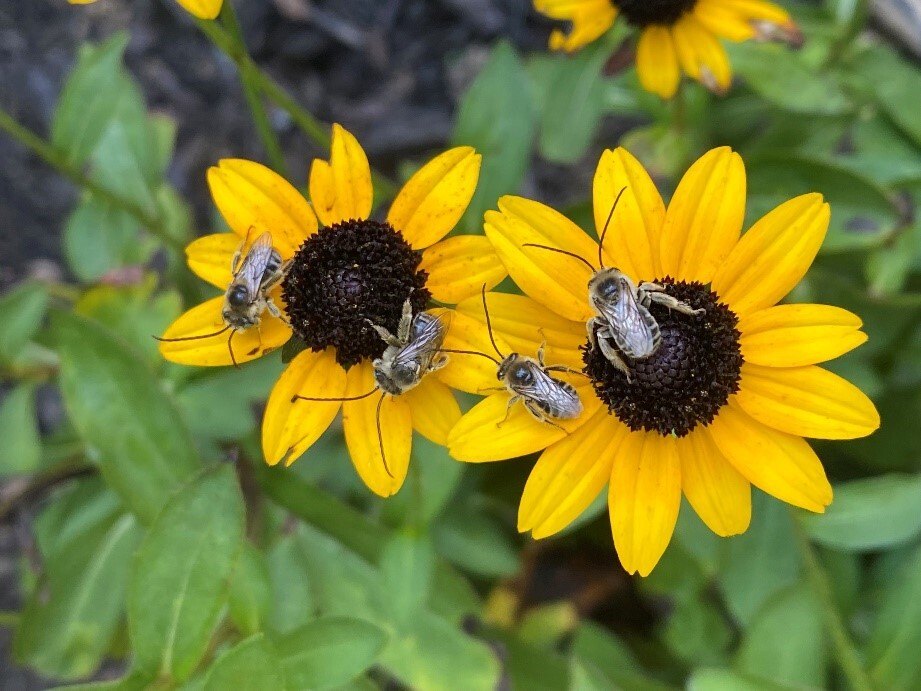
Between these plantings, naturally-occurring natives, and my routine transplantation of trees “gifted” to us by squirrels (such as bitternut and shagbark hickory, Carya cordiformis and C. ovata; tulip tree, Liriodendron tulipifera; and red oak, Quercus rubra) that get moved out into open areas of the yard a safe distance from the house, I would put our native species list at greater than 100. And I still think there’s room for more!
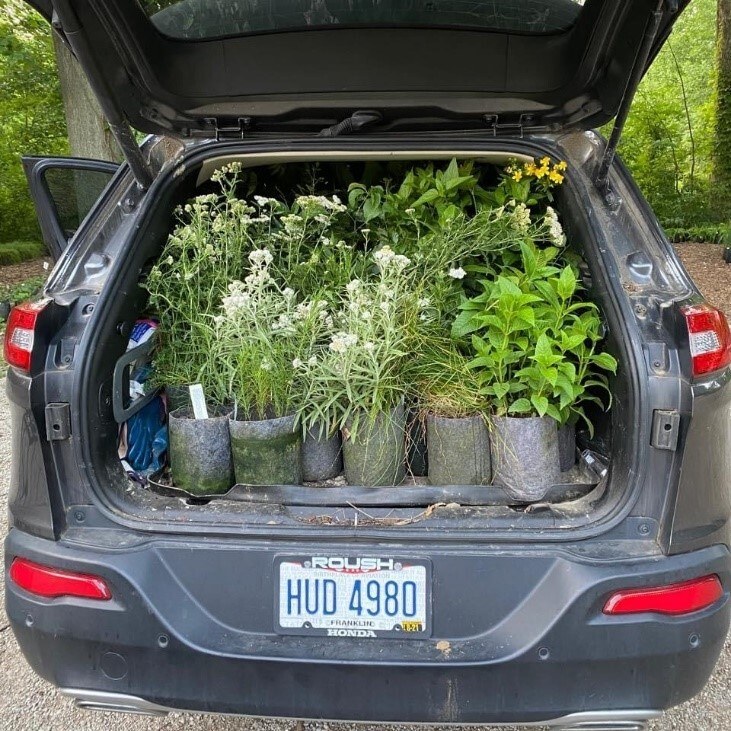
We have put in a great deal of effort to establish our landscape as one that is wildlife friendly. Nature rewards us daily with an abundance of pollinators (native bees, moths and butterflies abound!), toads, the occasional frog, great birds, and mammal visitors, as well. I love seeing the monarchs and swallowtails in the summer and goldfinches pulling seeds from our purple coneflower in fall. I am confident that our wetland garden deserves much of the credit for sustaining our neighborhood firefly population – providing enjoyment for us and our three (now adult) sons over the years. I hope that our future grandchildren will delight in the small miracles that unfold regularly through our efforts to work with nature – and that someday, we will see one of our grandkids planted in our yard, sketching some flowers and growing native.

